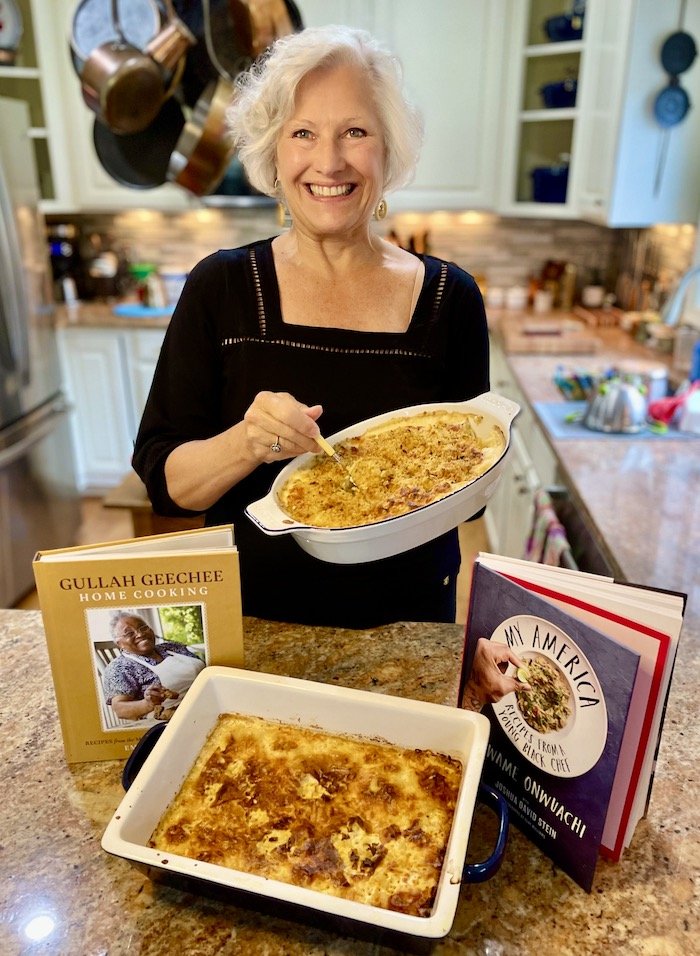The Storied And Delicious Dish: Mac And Cheese
I have a hankering (yes, that’s a word) for some comforting, delicious southern comfort food.
Alexandria is a southern town replete with history and traditions, some to celebrate, others to repair. I grew up in Alexandria, and many of my childhood memories revolve around summer fun and southern food. Every summer, family from the mid-Atlantic gathered here for a reunion complete with homemade hand-churned peach ice cream, cold lemonade, fried chicken, potato salad, gooey desserts, and Mac and Cheese.
Mac and Cheese is an iconic southern dish with as many recipes as there are regions in the south. For inspiration for my late summer cheesy feast, I headed to Red Barn Mercantile to browse through the many superb cookbooks and expanded kitchen offerings.
I was drawn to two books by black chefs from Red Barn’s thoughtfully curated collection of books and goods made by artisans, authors, and chefs of color. I couldn’t settle on one, so I decided to have a Mac and Cheese cook-off.
Famed chef Kwame Onwuachi has a new book titled My America: Recipes from a Young Black Chef. It is full of modern and creative twists on iconic soul food born of the African diaspora and his own family’s journey. Kwame has an elevated recipe for Mac and Cheese that smothers plump cavatappi pasta with silky Mornay sauce.
Emily Meggett, author of my second pick, offers a recipe that is bright yellow with mounds of sharp cheddar. Her charming and engaging book Gullah Geechie Home Cooking: Recipes from the Matriarch of Edisto Island invites you into her famed low country kitchen with a plethora of delicious tried-and-true recipes and family-centered stories. I found her warm smile on the cover irresistible.
Both of these famed black chefs from two different generations offer an important homage to the genesis of this now very American dish. Kwame sites its journey from Italy to Paris, where it landed in the capable hands of Paris-trained enslaved chef James Hemmings. Chef Hemmings took the original, added some French flair, and named it Macaroni Pie. It was beloved by Thomas Jefferson and was served at the White House while he was President.
There is value in learning the history of the foods that have become iconic in our cuisine. Mac and Cheese holds a starring role in the soul food repertoire because of the cost Chef Hemmings paid to bring us this dish. It is an American classic that began as an elevated dish prepared by, but not enjoyed by, the enslaved cooks on southern plantations. Today, it is enjoyed in roadside diners and upscale restaurants all over the Eastern United States.
I gathered my ingredients for both versions and began the preparation. There was a lot of excitement in my house since both recipes would have to be tasted and a winner declared.
Kwame’s sophisticated take on a classic honors the dish’s roots as one worthy of a White House dinner. Chef Kwame surrounds his cavatappi pasta in a smooth pearl white Mornay sauce enriched with garlic, four white cheeses, and a good grind of black pepper. The end product is luxurious; the billowy pasta almost floats in sauce, requiring a spoon to scoop a generous cloud onto your plate. Creamy richness balanced with a hint of black pepper spice and garlic depth glides onto your palate.
Emily’s recipe most resembles the James Hemmings era Macaroni Pie. In the recipe headnote, she says, “I believe that macaroni and cheese should be creamy, cheesy and just a little bit sweet. A can of Carnation milk and generous use of cheddar cheese does the trick.” This dish comes out of the oven with a crackly browned surface of baked cheese. The smaller elbow pasta forms a tight web with its baked cheesy companion; the whole is sliced like a pie offering warm, slightly sharp, slightly sweet bites from your fork.
My friends and family gathered to taste each recipe. I was at the ready with pen and paper to record scores. Everyone was too busy going back for seconds of both versions to vote, so we all agreed that no winner could be declared.
Mac and Cheese has a storied and complex history. Starting in the Paris kitchen of an enslaved American, it traveled across the ocean and, with each loving whisk and stir over the generations, became a culinary icon. Today, each family has its own version representing its unique American story.


